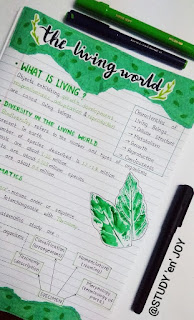Living World 1!
We can't classify an organism as living just by looking at it but there are some parameters that are taken into consideration. Such as if a body or organism can perform locomotion, excretion, and photosynthesis then we can say that a body is living! There are two types of features:
1. Characteristic feature: Characters or features which are common in both non-living and living but aren't a specific feature that we can call an organism living.
2. Defining features: Features that can be seen in only living. They are only seen in the living organism.
Growth, reproduction, ability to sense the environment and mount a suitable response come to our mind immediately as unique features of living organisms. Let's check out the defining and characteristic features of living organisms:
1. Growth: All living organisms grow. An increase in mass and an increase in the number of individuals are twin characteristics of growth! Intrinsic growth is defining feature of living beings. In the majority of higher animals and plants, growth and reproduction are mutually exclusive events. In unicellular organisms, growth is synonymous with reproduction a sit is a mutually inclusive feature, but in multicellular growth is a mutually exclusive event. An increase in body mass is considered growth. In non-living objects, there is an accumulation of material on the surface. In living organisms, growth is from the inside. Growth, therefore cannot be taken as a defining property of living organisms.
Growth is of two types:
1. Determinate growth: The period of growth is fixed.
2. Indeterminate growth: The period of growth is not fixed.
ASEXUAL AND SEXUAL ARE 2 TYPES OF REPRODUCTION IN ORGANISMS (FLOW CHART ON CANVAS)
2. Reproduction: It is a characteristic of living organisms. In multicellular organisms, reproduction refers to the production of progeny possessing features more or less similar to those of parents. When it comes to unicellular organisms like bacteria, unicellular algae, or amoeba, reproduction is synonymous with growth i.e, an increase in the number of cells. We have already defined growth as equivalent to increase in cell number or mass. Further, there are many organisms that do not reproduce (mules, sterile worker bees, infertile human couples, etc.). Hence, reproduction also cannot be an all-inclusive defining characteristic of a living organism. Though no non-living object is capable of reproducing or replicating by itself.
3. Metabolism: All living organisms are made of chemicals. There are thousands of metabolic reactions occurring inside all living organisms. The sum total of all the chemical reactions occurring in our body is metabolism. Anabolism is the formation of any molecule and catabolism means the breakdown of any molecule. The cellular organization of the body is the defining feature of life forms.
If reactions takes place inside the body then it is called invivo reactions. If reaction is taking place inside the test tube and outside the cell then it is called invitro reactions. Invitro reactions are neither living nor non living but they are living reactions!
4. Consciousness: The ability to respond to environmental stimuli is consciousness. Non-living never responds to the environment and hence it is not a feature of non-living bode but is seen in only living and thus is a defining feature of living organisms. Self-consciousness is the characteristic which is shown specifically only and only by human beings. But it is not shown by coma patient.
NCERT LINES: Properties of cellular organelles are not present in the molecular constituents of the organelles but arise as a result of interactions among the molecular components comprising the organelle. These interactions result in emergent properties at a higher level of organisation. This phenomenon is true in the hierarchy of organisational complexity at all levels.
Thus we can define living organisms are self-replicating, evolving, and self-regulating interactive systems capable of responding to external stimuli. There are nearly 1.7-1.8 million species that are known and described. This refers to biodiversity. All living organisms are linked to one another by the sharing of the common genetic material, but to varying degrees.
➖Nomenclature, identification, Binomial nomenclature:
1. Characterisation: It is the act of characterizing or describing the individual quality of a person or thing.
2. Nomenclature: A particular organism is known by the same name all over the world. This process is called nomenclature. Likewise, each and every organism has been given a specific name by which it is known all over the world.
For eg. Mangifera indica (Mango)
Solanum tuberosum (Potato)
3. Identification: Nomenclature or naming is only possible when the organism is described correctly and we know to what organism the name is attached. This is identification.
4. Classification: It is the process by which anything is grouped into convenient categories.
ICBN: International Code for Botanical Nomenclature.
ICZN: International Code for Zoological Nomenclature.
Each name has two components- the generic name and the specific epithet. This system of providing a name with two components is called Binomial nomenclature. This naming is given by Carolus Linnaeus. E.g., Mangifera indica, here, Mangifera represents the genus, and indica represents the species. Other universal rules of nomenclature are as follows:
1. Biological names are generally in Latin and written in italics. They are Latinised or derived from Latin irrespective of their origin.
2. The first word in a biological name represents the genus while the second component denotes the specific epithet.
3. Both the words in a biological name, when handwritten are separately underlined or printed in italics to indicate their Latin origin.
4. The first word denoting the genus starts with a capital letter while the specific epithet starts with a small letter. It can be illustrated with the example of Mangifera indica.
5.The name of the author appears after the specific epithet, i.e., at the end of the biological name, and is written in the abbreviated form.
For eg. Mangifera indica Linn.



